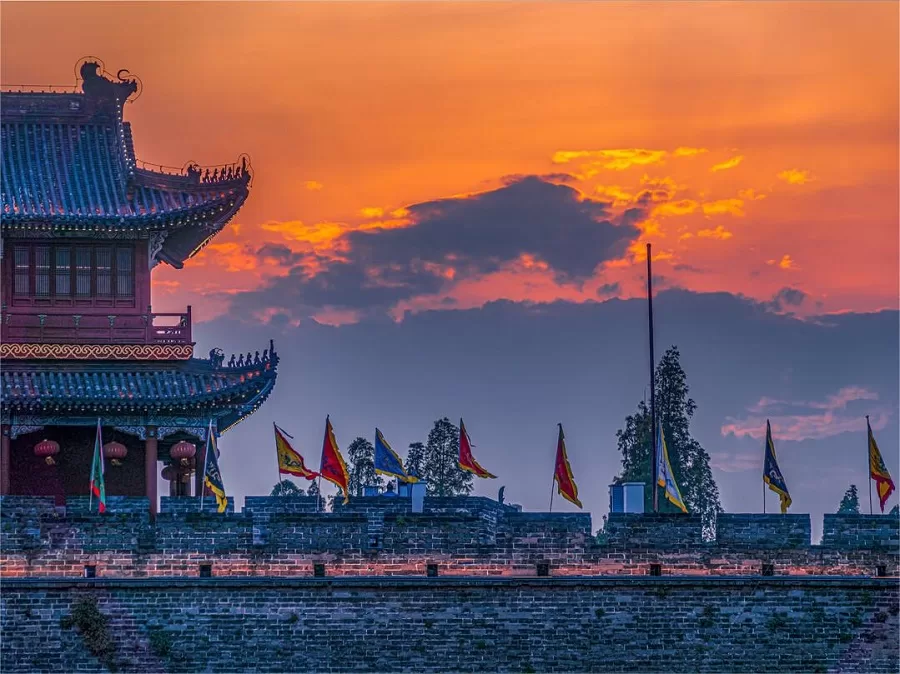Jingzhou Ancient City (荆州古城), also known as Jiangling City, stands as one of the best-preserved and grandest ancient cities in southern China. Located in the heart of the Jianghan Plain along the middle reaches of the Yangtze River, Jingzhou is a significant historical site where the splendid Chu culture, comparable to ancient Greek and Roman cultures, flourished alongside the Central Plains culture in the Yellow River basin.
During the Spring and Autumn and Warring States periods, the Chu State established its capital, Jian, five kilometers north of the present city, known as Jinan City, lasting for 411 years and leaving behind rich historical and cultural legacies. Jingzhou is also renowned as the birthplace and flourishing center of the Three Kingdoms culture. In the eras of Wei, Shu, and Wu during the Three Kingdoms period, the city became a strategic battleground. Subsequently, in the late Eastern Jin Dynasty, as well as during the Southern Qi Dynasty, the Liang Dynasty, the Later Liang Dynasty, and the Southern Han Kingdom of the Five Dynasties and Ten Kingdoms period, a total of 11 feudal lords established their capitals and ruled the region, leading to a historical span of over 100 years of continuous conflicts and changes of dynasties in Jingzhou.
Table of Contents
- Basic Information
- Location and Transportation
- Highlights of Jingzhou Ancient City
- Vlog about Jingzhou Ancient City
- Attractions within Jingzhou Ancient City
Basic Information
| Estimated Length of Tour | 2 hours |
| Ticket Price | Free, but you need to pay for the individual attractions within the ancient city |
| Opening Hours | 8.00 – 17.30; Last admission: 17.00 |
| Telephone Number | 0086-0716-8450389 |
Location and Transportation
Jingzhou Ancient City is located at 2 Zhang Juzheng Street, Jingzhou District, Jingzhou City, Hubei Province, China. To get there, you can take bus 15, 20, 21, 24, 25, 29, or 104 and get off at Jingzhou Ancient City Tourist Center Stop (荆州古城游客中心站).
Highlights of Jingzhou Ancient City
Ancient City Wall

The ancient city wall of Jingzhou forms an irregular oval shape, measuring 3.75 kilometers from east to west, 1.2 kilometers from north to south, with an area of 4.5 square kilometers. The wall has a circumference of 11.28 kilometers, an average height of 8.83 meters, 4567 battlements, 26 cannon platforms, and 5 hidden military tunnels. Jingzhou Ancient City has a total of 6 old city gates, including 2 city gate towers (Binyang Tower in East Gate and Chaozong Tower in Grand North Gate). The city is divided into three layers, with a water city on the outside, a brick city in the middle, and an earthen city on the inside. The water city (protective moat) is approximately 13,000 meters long, 30-250 meters wide, with an average water depth of 4 meters. It connects to Taihu Lake in the west, the Yangtze River in the east, and is linked to the ancient Grand Canal.
During the Ming Dynasty, when the city was built, to prevent the city’s foundation from sinking and flooding during heavy rains, the city wall was constructed with a stone base and brick walls. The wall was built with a unique technique, using glutinous rice lime mortar for sealing, making the city wall exceptionally robust and historically known for being easily defendable and difficult to attack, earning the moniker “Iron-clad Jingzhou.”
Light and Shadow Show

Jingzhou Ancient City’s East Gate Light and Shadow Show uses water as a stage, the city wall as a screen, and lighting as the medium, interpreting the unique urban brand and cultural connotations of Jingzhou. In the backdrop of the lights, the ancient city wall, Binyang Tower, soaring golden phoenix, Nine Dragon Pillars, and the statue of Qu Yuan illuminate with vibrant colors. The light and shadow show is divided into four chapters: Heaven, Earth, People, and Harmony. Each scene tells a story showcasing the cultural history and tourism resources of Jingzhou, creating a mesmerizing spectacle that comes to life during a boat tour, opening a new chapter for night tours of the ancient city.
Boat Tour

Embark on the Jingzhou-themed boat, and cruise along the ancient protective moat to experience the historical and cultural attractions of the Jingzhou Ancient City Tourism Zone. The ancient protective moat, created by connecting natural lakes and ponds, offers a wide water area with winding shores, preserving the natural beauty of the original lakes. Lined with green trees, the riverbanks showcase the natural charm of a Hubei water town, allowing passengers to fully appreciate the sights such as the Jingzhou Ancient City Wall, Binyang Tower, Nine Dragon Bridge, Mingyue Bridge, the statue of Qu Yuan, and the wetland park – Mingyue Park, among others. The boat journey provides a delightful way to explore the cultural and scenic treasures of Jingzhou.








